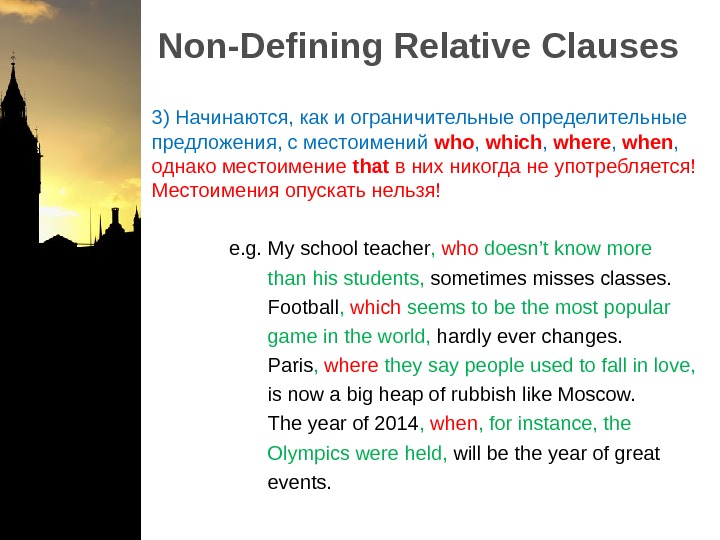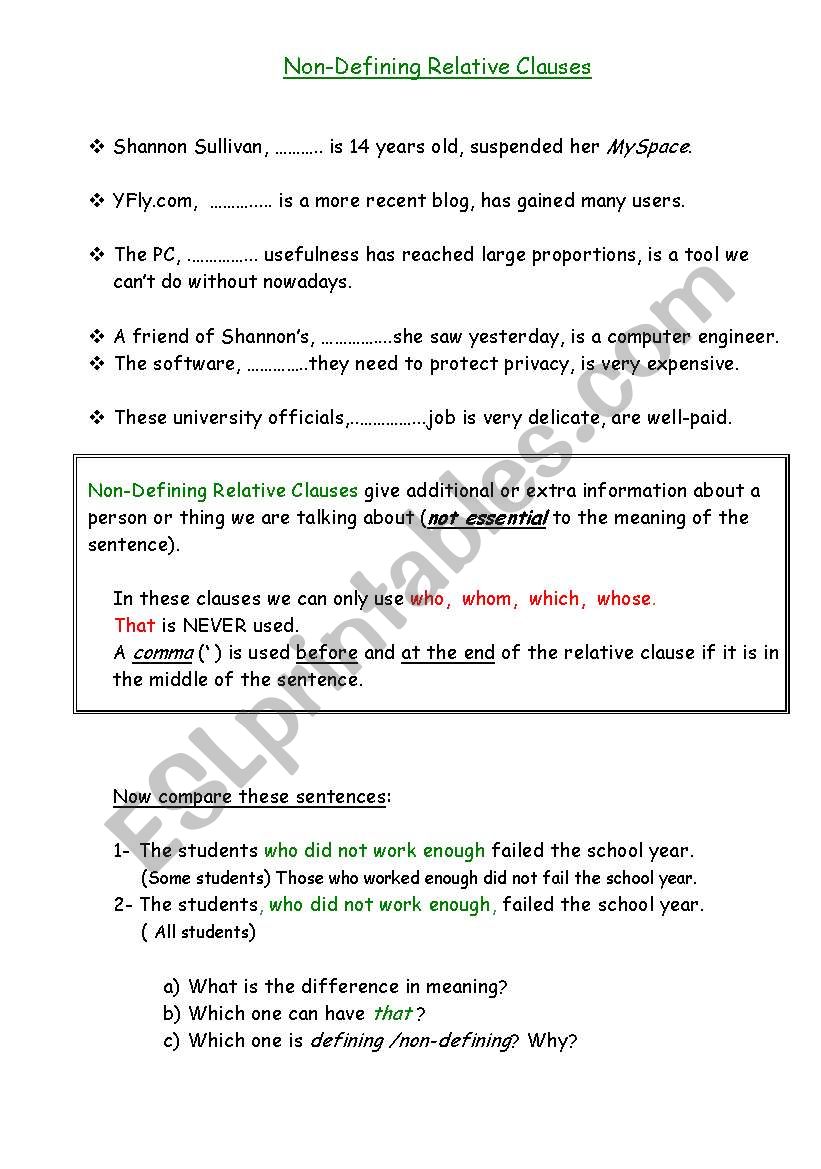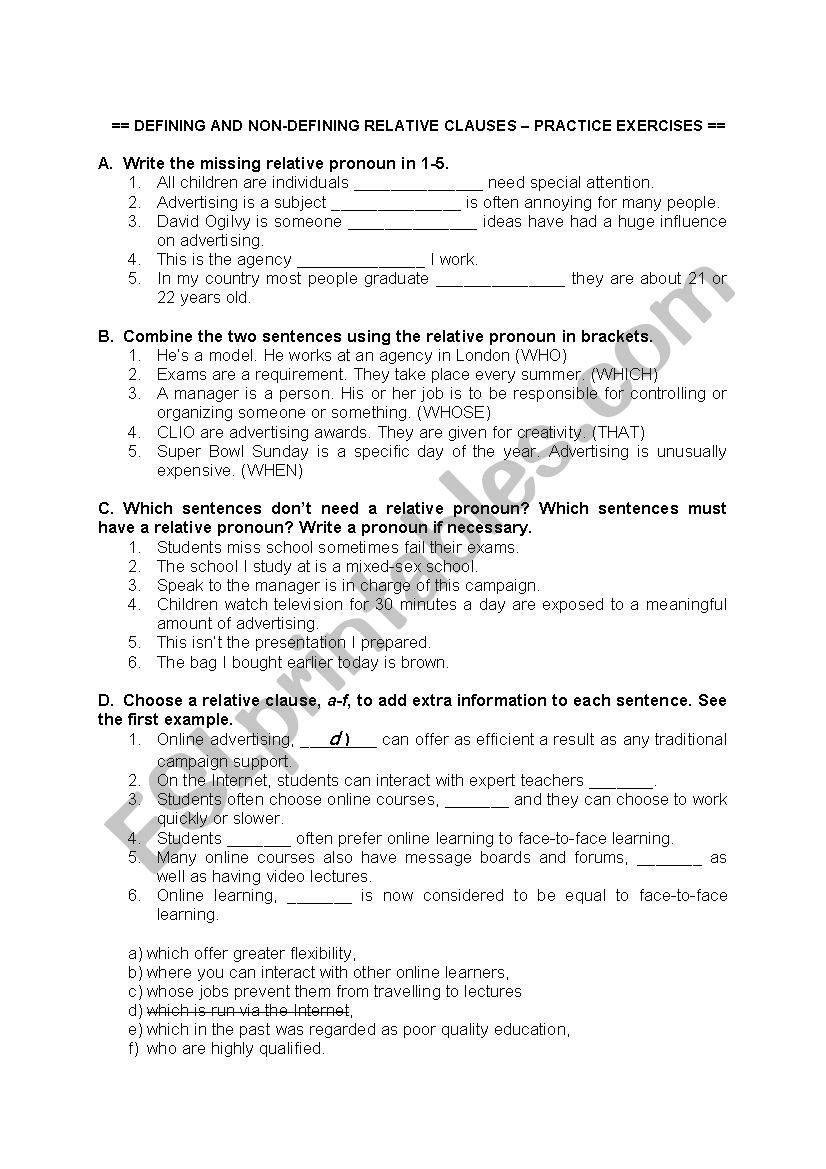In defining relative clauses, the pronouns who, whom, and which are often replaced by that in spoken English. In non-defining relative clauses, you cannot replace other pronouns with that. You also cannot leave out the relative pronoun in non-defining relative clauses, in the way you sometimes can in defining relative clauses.
The pronoun is required, even when it is the object of the verb in the relative clause. Finally, non-defining relative clauses are always separated from the rest of the sentence by commas, unlike defining relative clauses, which have no punctuation. It is also possible to present all the grammar through separate sentences. For the first stage students can simply match the vocabulary to the definitions.
Alternatively, for more challenge you can split the definitions into two and get them to match the words to two parts and/ or think about which bits go together. They can then analyse the language in those definitions for what relative pronouns are used, etc. Concerning the choice of relative adverbs or pronouns, the relative adverbs "where", "when" and "why" can be used for location, time, and the reason for something happening, respectively. All can be replaced by "that" in defining relative clauses but, as stated above, if "that" (or "which") replaces "where" an extra preposition must be added to the sentence. We use "which" for things and "who" is used for people, and in defining relative clauses "that" is also always possible. Remember, it is not possible to use "that" in a non-defining relative clause.
Relative clauses that give additional information are called 'defining'. Relative clauses are always in the middle of a sentence. We can use exactly the same relative pronouns in defining and non-defining relative clauses. The punctuation is different for defining and non-defining clauses.
Defining And Non Defining Relative Clauses Commas On the other hand, a non-defining relative clause adds an extra, non-essential piece of information to a sentence. In non-defining relative clauses, the relative pronoun or adverb cannot be replaced by "that" and the clause must be separated from the rest of the sentence by commas. This all leaves "that" as the only major difference in pronouns between defining and non-defining relative clauses. However, another difference related to pronouns is that relative pronouns cannot be removed from non-defining relative clauses, unlike in defining relative clauses. Non defining relative clauses exercises pdf provides a comprehensive and comprehensive pathway for students to see progress after the end of each module.
Clear and detailed training methods for each lesson will ensure that students can acquire and apply knowledge into practice easily. The teaching tools of non defining relative clauses exercises pdf are guaranteed to be the most complete and intuitive. Students fill in "five down", "four across", etc with words and expression that match the definitions which are given. If you give them Student A and Student B versions of a crossword with different answers already completed, the same can also be done orally.
We can find non-defining relative clauses either after the subject or after the object of the main clause. They are introduced by a relative pronoun followed be the relative clause and, if they identify the subject, the verb of the main clause. They are always separated by commas from the main clause. We use non-defining relative clauses to give extra information about something - either the previous noun , or all of the previous information . For more information about words like which and whom, look at the relative pronouns page).
Reduced relative clauses are especially common in academic English. There is another whole article on reduced relative clauses on this site. Relative clauses which give us additional information about a noun or noun phrase and are introduced with a relative pronoun. These are classic non-defining relative clauses. Non-defining relative clauses are composed of a relative pronoun, a verb, and optional other elements such as the subject or object of the verb.
Commas or parentheses are always used to separate non-defining relative clauses from the rest of the sentence. In both of these examples, using that would not be appropriate (e.g. This pen, that I bought two days ago…). This is because the sentences use non-defining relative clauses. They add extra information to the sentence, but that information does not define the noun. The sentences would have the same meaning without the relative clauses.
A relative clause is an added part in a sentence that is used in relation to the main sentence. However, sometimes a relative clause is so important that the main sentence will be difficult to understand or have no meaning without it. This is called a defining relative clause.
On the other hand, we often use a relative clause just to add extra information, which is usually indicated by the use of commas. The meaning of the main sentence will still be clear without it and it is therefore called a non-defining relative clause. By using commas in written English and a slight pause in spoken English, two identical clauses can have different meanings when used in a sentence. Other relative pronouns ("which", "who", "whose", "preposition + which", and "whom" if you decide to teach it) can be used in exactly the same way in defining and non-defining relative clauses.
The same is true about the relative pronoun "why" in "the reason why…", but as this is the only time that "why" is a relative pronoun, I generally don't present it at all. I therefore don't teach this as a difference. There are also non-defining relative clauses. We use them to give extra information about the person or thing that is not important. We use commas in non-defining relative clauses, but we don't use the relative pronoun "that". While standard non-defining relative clauses are used much more in writing than in spoken English, these connective relative clauses are quite common in spoken language.
I have written a separate post about them , and the next two exercises are taken from that post. Non-defining relative clauses are also known as non-identifying relative clauses or non-restrictive relative clauses in English, and are used with commas. The relative clause is not necessary, because even without the rit we would still understand who or what is being referred to.
Non-defining relative clauses are different from defining relative clauses. In the second sentence there is no comma -who work very hardis necessary to the meaning of the sentence because it explains which teachers we are talking about. Non-defining relative clauses need commas around them, while defining relative clauses don't. Non-defining relative clauses are also less common in informal, spoken English.
One of the features of written academic English that gives it its greater complexity is longer sentences, with more frequent use of subordinate clauses. A clause is part of a sentence and a subordinate clause is a group of words with a subject and a verb that cannot stand alone as a sentence. Relative clauses, both defining and non-defining, are a kind of subordinate clause. Defining ones tell us which thing or person is being referred to, or what kind of thing or person the writer or speaker means. Non-defining ones just add extra, non-essential information about the person or thing being referred to. This Learning Object will provide you with the rules about their use and show you ways that they can sometimes be shortened or replaced by noun phrases to create a more concise style.
The following relative pronouns are used in non-defining relative clauses. These relative pronouns appear at the start of the non-defining relative clause and refer to a noun that appears earlier in the sentence. Both defining and non-defining relative clauses give extra information about the main clause. This defining relative clause is, as the name suggests, defining which brother I am talking about.
Such clauses are used to provide additional or extra information in conversations. While providing brief information about a noun, non-restrictive relative clauses are not used. For example, in the sentence "James, who stood first in class, work really hard" the clause who stood first in class is a non-restrictive form. Non-defining Relative Pronouns Exercise Three things about Non-defining Relative Clauses. The relative clause is closed off by commas and is quite similar to information in brackets. Non-defining relative clauses are NOT used in spoken English.
The relative pronoun can never be omitted. Relative clausesadd extra information to a sentence by defining a noun. They are usually divided into two types –defining relative clausesandnon-defining relative clauses. Students make or are given a short sentence like "This school is in a suburb" and take turns making it longer by adding extra words, clauses, etc. They continue making it longer and longer until they add something untrue, give up, or need to add a full stop.
Both defining and non-defining relative clauses should naturally come up in this game without any specific encouragement. A slightly more challenging and interesting task after the comprehension questions is for students to be given the same text with the relative clauses taken out and mixed up. Ask the students to put the text back together from memory, logic and their grammar knowledge. After the analysis stage, they could then put in a few extra relative clauses which you left out of the original text and/ or which you wrote to also go in there.
Relative clauses like "What's the English for a thing which opens wine bottles? " and "Jane, who had never met Steve before, was intrigued to find out more" are vital both for classroom communication and for comprehending all but the simplest English texts. A clause is a set of words that has a subject and verb present, but it is not a complete thought . When a group of collective words do not have both a subject and a verb, it is called a phrase. Relative clauses have a remarkably similar job as an adjective. These are clauses that give more information about the noun that is present.
They are super helpful to authors because they can help you clarify the vision and essence of what you are exploring for your readers. We will show you how using the correct pronoun can make or break the entire process. These worksheets will help you identify and use relative clauses productively in your own writing.
They will also help you better understand the proofreading and editing process to heighten your work and that of others. These sentences have had all their commas removed. Tick those sentences which refer to the whole of the previous clause rather than to a noun or noun phrase. While both types of relative clauses add extra information to the sentence, a defining relative clause clearly adds detail about a specific noun that is defined.
In the following defining relative clauses, put a tick if the relative pronoun ('that', 'who' which' etc.) can be omitted. If it cannot be omitted, leave the box empty. Remember it is only possible to omit the relative pronoun if it is the object of a defining relative clause. Non-defining relative clauses are separated from the rest of the sentence by commas.
These examples use defining relative clauses; they define the noun by telling us who or which noun it is specifically . If you remove the defining relative clause from the sentence, then we might not understand who or which noun is being spoken about. Choose the correct relative pronoun or adverb for the following defining and non-defining relative clauses. As which brother is defined in other ways, this is a non-defining relative clause.
A restrictive relative clause is used to provide information about the noun. Without the information that restrictive form provides, the sentence will get difficult to understand. With these types of clauses, pronouns 'that' and 'which' are used for nonliving entities. For the living entities, pronouns 'that' and 'who' are used.
The use of commas is prohibited when using them in these types of situations. As these are very similar in construction, they are usually all treated as non-defining relative clauses in EFL/ESL. So for most foreign learners it won't be necessary to learn or remember the terms sentential and connective.
But judging by comments in ESL forums, there are some students who are taught these terms, so hopefully this post will be able to clarify things a bit. Defining and non-defining clauses are both types of relative clauses – clauses that share some extra information about something. Non-defining relative clauses add non-essential information to a sentence and can be left out of a sentence without changing it's meaning.
Non-defining relative clauses are usually separated by commas in writing. A relative clause is one that adds information to a sentence, in relation to a noun. For example, in the sentence "I will buy the car that costs the least." Relative clauses can be connected to sentences by relative pronouns, who, which, that, whom and whose. However, there are still times when you cannotuse that.
Non-defining relative clauses are clauses that give extra and not necessary information about a person or a thing. You can also learn more about relative clauses by reading Defining Relative Clauses. Non-defining relative clauses are used between commas, and they add extra information which is not necessary to know who or what we are talking about. They can then look at the text again for how the word "that" is used, how commas are used, etc.
This post mainly consists of exercises, and we'll start by looking at the differences between defining and non-defining relative clauses. Note thatnon-defining relative clausesare always separated by commas. You may have noticed another difference between defining and non-defining relative clauses, and that is with commas.


























